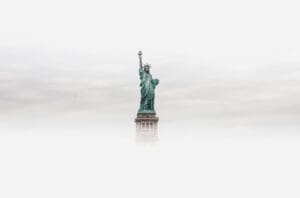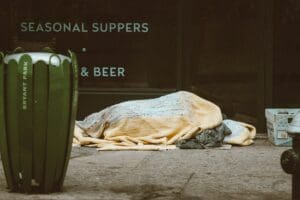Anne Case and Angus Deaton provide a compelling account of the problem, but anemic solutions. The epidemic of deaths of despair will continue unless we attempt bolder solutions like universal basic income to address it.
By Mark Pancer
As I write this review, the world is in the throes of the worst pandemic it has seen in a century. Globally, hundreds of thousands have had their lives cut short by the COVID-19 virus, millions have been infected and the end of the pandemic is nowhere in sight. The United States has been hit a body blow by the virus, experiencing more deaths and infections than any other country in the world. As of May 12 of 2020, the virus had claimed more than 80,000 American lives, some 29 per cent of the world’s total.

But this is not the only epidemic that the United States is currently experiencing.
According to Princeton economists Anne Case and Angus Deaton in their book Deaths of Despair, America was already in the midst of an epidemic – one that has shortened the lives of many more people than COVID-19 – before the novel coronavirus even reared its head.
The term deaths of despair is one that Case and Deaton began to use after discovering that thousands of Americans were dying of three interrelated causes, all rooted in feelings of despair: opioid overdoses, suicide and alcohol-related diseases such as cirrhosis of the liver.
So many lives have been lost to these causes that over the last few years the United States, unlike any other country in the developed world, has experienced a decrease in longevity – the first such decrease in a century.
In a groundbreaking study published in the Proceedings of the National Academy of Sciences in 2015, Case and Deaton discovered that deaths of despair were hitting one segment of the American population much more than any other: middle-aged white, non-Hispanic men and women.
In subsequent research, they found that the epidemic was even more concentrated; its primary effects were among middle-aged white Americans without a college education.
Their book provides an in-depth account of their exploration into why this group of Americans has suffered from deaths of despair so much more than any other, including black and Hispanic Americans, who, on average, have even lower incomes than this group does.
Up until about 1999, mortality rates followed the same downward trajectory among midlife whites (aged 45 to 54) in the United States as they did in almost all wealthy countries. This trend reversed itself around 1999, when mortality rates for American whites started increasing, while those of other countries continued their decline. Case and Deaton determined that if the trend of decreasing mortality rates had continued in the United States, there would have been more than 600,000 fewer deaths among midlife Americans. These numbers indicate an epidemic that, to date, surpasses COVID-19 in terms of its destruction of life.
The despair experienced by midlife, less educated white Americans is evident in many aspects of their lives. According to national health surveys, by a ratio of nearly 3 to 1, individuals in this group are more likely than those with a degree to rate their health as poor or only fair. They are also more likely to experience symptoms of severe mental distress, such as feelings of sadness, hopelessness and lack of self-worth. Differences between less and more educated whites are evident in their physical capabilities as well.
Those without a bachelor’s degree report more difficulty in going about everyday activities, such as climbing stairs, going out to shop or walking short distances.
In 2017, 13 per cent of midlife whites without a college degree reported that they were unable to work, compared to fewer than 2 per cent of those with a degree.
Underlying many of these complaints is the experience of physical pain. Reports of being in pain have been increasing steadily in middle-aged Americans, to the extent that those in midlife report more pain than do older Americans. According to Gallup polling, in which Americans were asked if they had experienced significant pain “yesterday” – that is, the day before they were asked the survey questions – nearly 30 per cent of whites indicated that they had. Once again, however, there were substantial differences between those with a college degree and those without, with much higher proportions of less educated white Americans indicating that they had experienced significant pain the previous day. In looking at the distribution of “pain yesterday” across the country, Case and Deacon found that pain was more prevalent in areas with lower levels of education, such as Appalachia, than in areas with higher levels of education, such as the Bay Area of California.
Interestingly, those areas with high proportions of individuals reporting pain were more likely to have a majority voting for Donald Trump in the 2016 presidential election.
According to the authors, physical pain, mental distress and death are fueling the despair that is felt by white Americans without a college degree.
But what has caused the suffering and despair that has increased so precipitously over the last 20 years for this segment of the U.S. population?
Poverty is one possible answer, but Case and Deaton argue that poverty is a “false trail” in the pursuit of an explanation for the phenomenon. For one thing, the timing and direction of changes in poverty levels and deaths of despair do not match up. Poverty rates declined in the years following the Great Recession of 2008–09, while deaths of despair increased. Also, less educated whites had higher incomes than blacks over this period, but blacks, even though they were poorer, were not experiencing nearly as many deaths of despair, and their mortality rates were not increasing. If poverty had had a straightforward causal effect on deaths of despair, one would have thought that the Great Recession would have resulted in a huge jump in deaths.This did not happen, even in countries like Greece and Spain, where incomes fell as unemployment rates more than doubled over the course of the recession.
Another possible explanation for the growing divide between white Americans with and without a college degree has to do with the kinds of work that these two groups do.
In addition to providing wages, work gives meaning, status and a sense of identity to people’s lives. It also provides the resources necessary to marry and have children.
Case and Deaton talk about two escalators related to work – one for the educated and one for the relatively uneducated. After 1970, the escalator for those with a college degree started moving faster than it ever had before; salaries and living standards increased rapidly. The escalator for those without a degree “was stalled or hardly moving at all.” These individuals experienced deteriorating living standards and very few prospects for the future.
The result was steadily increasing income inequality, and even increased physical separation, between the educated and uneducated groups.
In contrast, black Americans, though they earned less than whites, saw their incomes increase over time, and so they did not experience the same kind of “stalled elevator” phenomenon that less educated whites did.
Case and Deaton talk about a “college premium” – the additional income that individuals with a college degree earn compared to those without a degree. That premium has increased substantially over time. It has occurred not only because those with a college degree earn substantially higher incomes, but because those without a degree have experienced a reduction in their earnings.
But more important than the declining incomes experienced by whites with less education is the kind of work they were now doing.
As well-paid, unionized jobs in manufacturing disappeared with automation or were outsourced to other countries, those who could find work moved to nonunionized, lower-paid and lower-status jobs. They ended up working for companies that supply cheap labour to corporations such as Google or Facebook, without even benefiting from any status that they might have derived from being employed by a high-profile corporation.
The personal consequences of this degradation of employment for the less educated have been dramatic. Whites without a college education have been increasingly less likely to get married, belong to churches or clubs or have stable families.
Deprived of the social capital that these connections provide, they succumb to despair.
The proportion of less educated midlife whites who, in national surveys, reported being unhappy with their lives has increased steadily since the late 1990s, while it has remained constant (and much lower) among those with a college degree.
The longer title of Case and Deaton’s book is Deaths of Despair and the Future of Capitalism (emphasis added). The last few chapters of the book form a section entitled “Why is Capitalism Failing So Many?” Like others who have decried the “crony capitalism” that has become increasingly prevalent in the United States, Case and Deaton lay the blame for much of the pain experienced by less educated whites on an economic system that has been manipulated by the wealthy and powerful to reward an educated elite at the expense of less educated working Americans. These wealthy individuals and corporations have used their considerable resources to induce legislators to enact policies and regulations that protect them from competition and allow them to reap huge profits by keeping down the wages and benefits of less powerful groups such as whites without a college education.
According to Case and Deaton, nowhere is this process more evident than in the American health care system, which they describe as “a leading example of an institution that, under political protection, redistributes income upward to hospitals, physicians, device makers, and pharmaceutical companies while delivering among the worst health outcomes of any rich country.”
The cost of this system is enormous – nearly 20 per cent of the country’s GDP in 2017, considerably more than any other country spends on its health care.
At the same time, the outcomes of these expenditures are much worse than the outcomes experienced by other wealthy countries.
For example, countries such as Canada, the U.K., Australia and Switzerland spend thousands less per capita on their health care systems, but citizens of these countries can expect to live years longer than Americans can. Case and Deaton determined that if Americans spent as much on health care as Canadians did, they would save $1.4 trillion, equivalent to $11,000 per household.
The difference in costs between the United States and other wealthy countries comes from higher salaries for health care providers, higher costs of drugs, medical procedures and administration, and more extensive (and unnecessary) use of expensive diagnostic procedures, among other things.
Case and Deaton suggest that the health care industry, which spent more than $500 million on lobbying in 2018, is a “protection racket” – one of the largest “forces redistributing power from labor to capital, and from workers and consumers to corporations and wealthy professionals.”
In the last chapter, the authors address themselves to the question of what can be done to lessen despair among less educated whites and the destruction of quality and length of life that it produces.
They consider a number of possible ways in which this might be accomplished. Given their complaints about the health care system, one of their major recommendations is to provide universal health insurance, with cost controls, in the way that other wealthy countries do. Another of their recommendations is to increase the minimum wage substantially (from $7.25 per hour at the time of writing the book to $15).
They consider, and reject as a potential solution, the provision of a universal basic income to those whose incomes are below the poverty line, because they claim that it might keep people from seeking employment.
This, they surmise, would result in more people not working, and therefore foregoing the economic, social and status benefits that being employed can provide. They also reject increasing taxes on the wealthy; rather, they would ensure that rich individuals and corporations cannot use their power to enrich themselves by exploiting the less educated. This would be accomplished through stricter enforcement of antitrust laws and putting a stop to “rent-seeking” – using political means to unfairly advantage wealthy and powerful individuals and corporations so as to maintain or increase their profits.
Deaths of Despair is an important book. It clearly and compellingly tells the story of how the lives of whites without a college education have been degraded to the extent that thousands are destroying themselves through suicide, opioid overdose and alcohol abuse.
And they are not only destroying themselves. They have become a political force that helped elect a president whose failings have wreaked havoc on the American economic and political system, especially during the COVID-19 pandemic.
The authors also provide a compelling account of the profound way in which the health care system in the United States has harmed rather than helped the economic and physical health of its citizens, particularly its less educated citizens.
The strategies that Case and Deaton offer for dealing with this epidemic of deaths of despair, unfortunately, are rather anemic. While they at times indicate that some of their suggested strategies might provoke opposition from the wealthy and powerful, they seem not to acknowledge that substantial political force would need to be applied to counteract this opposition.
And some of the strategies that they dismiss as ineffectual may be much more effective than they think. They suggest, for example, that a universal basic income might reduce the incentive to seek employment, even though recent research suggests that such a policy not only does not reduce job-seeking, but in addition gives people the opportunity to further their education, gain new skills or contribute to their communities in other ways, rather than just through their jobs. Indeed, President Richard Nixon came very close to enacting a universal basic income in the United States more than 50 years ago. Imagine how much easier it would have been to support people through the economic disruption of the COVID-19 pandemic if such a policy had been in place today.
Indeed, when the COVID-19 pandemic is over, the epidemic of deaths of despair will continue unless we attempt bolder solutions like universal basic income to address it, rather than merely tinkering with things like the minimum wage or the enforcement of antitrust laws.
_____
Mark Pancer is Professor Emeritus of Psychology at Wilfrid Laurier University in Waterloo, Ontario, and author of The Psychology of Citizenship and Civic Engagement (New York: Oxford University Press, 2015). Read More
To see original article please visit: https://inroadsjournal.ca/the-other-epidemic-deaths-of-despair/





















